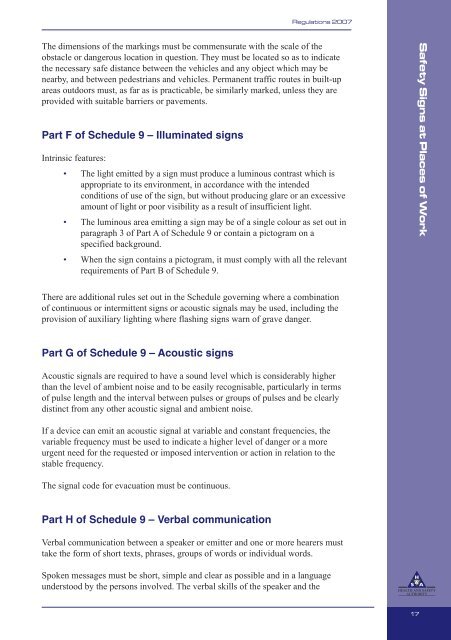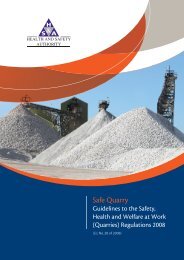Safety Signs at a Place of Work 2010 - Health and Safety Authority
Safety Signs at a Place of Work 2010 - Health and Safety Authority
Safety Signs at a Place of Work 2010 - Health and Safety Authority
Create successful ePaper yourself
Turn your PDF publications into a flip-book with our unique Google optimized e-Paper software.
Regul<strong>at</strong>ions 2007<br />
The dimensions <strong>of</strong> the markings must be commensur<strong>at</strong>e with the scale <strong>of</strong> the<br />
obstacle or dangerous loc<strong>at</strong>ion in question. They must be loc<strong>at</strong>ed so as to indic<strong>at</strong>e<br />
the necessary safe distance between the vehicles <strong>and</strong> any object which may be<br />
nearby, <strong>and</strong> between pedestrians <strong>and</strong> vehicles. Permanent traffic routes in built-up<br />
areas outdoors must, as far as is practicable, be similarly marked, unless they are<br />
provided with suitable barriers or pavements.<br />
Part F <strong>of</strong> Schedule 9 – Illumin<strong>at</strong>ed signs<br />
Intrinsic fe<strong>at</strong>ures:<br />
• The light emitted by a sign must produce a luminous contrast which is<br />
appropri<strong>at</strong>e to its environment, in accordance with the intended<br />
conditions <strong>of</strong> use <strong>of</strong> the sign, but without producing glare or an excessive<br />
amount <strong>of</strong> light or poor visibility as a result <strong>of</strong> insufficient light.<br />
• The luminous area emitting a sign may be <strong>of</strong> a single colour as set out in<br />
paragraph 3 <strong>of</strong> Part A <strong>of</strong> Schedule 9 or contain a pictogram on a<br />
specified background.<br />
• When the sign contains a pictogram, it must comply with all the relevant<br />
requirements <strong>of</strong> Part B <strong>of</strong> Schedule 9.<br />
<strong>Safety</strong> <strong>Signs</strong> <strong>at</strong> <strong>Place</strong>s <strong>of</strong> <strong>Work</strong><br />
There are additional rules set out in the Schedule governing where a combin<strong>at</strong>ion<br />
<strong>of</strong> continuous or intermittent signs or acoustic signals may be used, including the<br />
provision <strong>of</strong> auxiliary lighting where flashing signs warn <strong>of</strong> grave danger.<br />
Part G <strong>of</strong> Schedule 9 – Acoustic signs<br />
Acoustic signals are required to have a sound level which is considerably higher<br />
than the level <strong>of</strong> ambient noise <strong>and</strong> to be easily recognisable, particularly in terms<br />
<strong>of</strong> pulse length <strong>and</strong> the interval between pulses or groups <strong>of</strong> pulses <strong>and</strong> be clearly<br />
distinct from any other acoustic signal <strong>and</strong> ambient noise.<br />
If a device can emit an acoustic signal <strong>at</strong> variable <strong>and</strong> constant frequencies, the<br />
variable frequency must be used to indic<strong>at</strong>e a higher level <strong>of</strong> danger or a more<br />
urgent need for the requested or imposed intervention or action in rel<strong>at</strong>ion to the<br />
stable frequency.<br />
The signal code for evacu<strong>at</strong>ion must be continuous.<br />
Part H <strong>of</strong> Schedule 9 – Verbal communic<strong>at</strong>ion<br />
Verbal communic<strong>at</strong>ion between a speaker or emitter <strong>and</strong> one or more hearers must<br />
take the form <strong>of</strong> short texts, phrases, groups <strong>of</strong> words or individual words.<br />
Spoken messages must be short, simple <strong>and</strong> clear as possible <strong>and</strong> in a language<br />
understood by the persons involved. The verbal skills <strong>of</strong> the speaker <strong>and</strong> the<br />
17

















